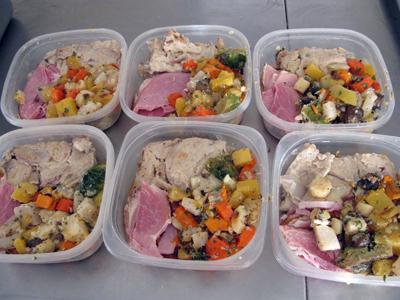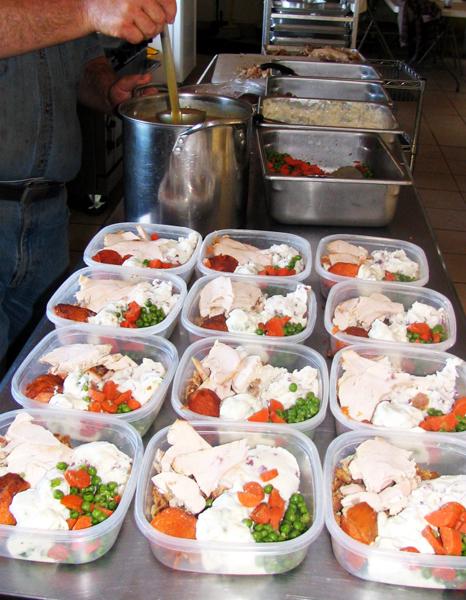-
Posts
254 -
Joined
-
Last visited
Content Type
Profiles
Forums
Store
Help Articles
Everything posted by xxchef
-
I've been working in commercial kitchens for over 35 years and have never seen or heard of a really good way of dealing with this situation. We run a tight ship and very clean operation but, despite every possible effort, every once in a while we see a house fly in the kitchen. We use fly predators outside, bug zappers & sticky sheets, good screens on everything and positive refuse controls but they still come in sometimes. Usually I can shoo them away from the production area and then swat them, clean & sanitize and be good to go again. My personal dread is to be in the middle of a health department (or other) inspection and have one buzzing around his head. How would you handle this?
-
I know this says "2012" on the title but I just had to "bump it up" with this gem: Hold the Meat: White Castle Introduces New Veggie SliderFull article here: http://www.nbcnews.com/business/consumer/hold-meat-white-castle-introduces-new-veggie-slider-n277261
-
My notes say that Jean Marie expects 90 day (60 day guarantee) shelf life @ 0.62 aW and that 0.72 - 0.75 aW = maybe 5 weeks life. What was that one ganache Melissa made, 0.96, I think?, and he said "Eat it within one day".
-

Plan: 2014 Chocolate & Confectionery Workshop Las Vegas
xxchef replied to a topic in Pastry & Baking
Still "on the fence" for this one. Awaiting feedback from my plus one and will get back to you ASAP if "yes". -

Plan: 2014 Chocolate & Confectionery Workshop Las Vegas
xxchef replied to a topic in Pastry & Baking
Please sign me up for the Thursday Lotus dinner. Thanks. -
Thanks so much for the excellent suggestions. I don't know why I didn't think of curd. I love lemon curd but it didn't occur to me for the oranges. I was not aware about the bitterness factor for Navels and will have to keep that in mind. Re-gifting is a fun idea too. Thanks all.
-
It's citrus season in the south west and several well intentioned (but obviously overwhelmed) friends have shared with us their backyard bounty. I now have well over 50 lbs of mixed orange citruses (oranges, tangerines, tangelos etc). They are awesome, delicious, sweet, juicy and perfect but how many oranges can 2 people eat? I'll probably make some marmalade, juice some and puree up some more to freeze for future fruit-based beverage and confection experiments but I could really use some help on a few good, solid everyday uses to put them to. Just got off the phone. Another friend is on her way with a "big box of citrus" for us. Maybe it will be lemons or limes? Help?
-

Plan: 2014 Chocolate & Confectionery Workshop Las Vegas
xxchef replied to a topic in Pastry & Baking
Congrats to our own Rob Connoley (The Curious Kumquat in Silver City, NM) for being nominated by the James Beard Foundation for Best Chef: Southwest! http://www.jamesbeard.org/blog/2014-restaurant-and-chef-award-semifinalists That's awesome, Rob! -

Plan: 2014 Chocolate & Confectionery Workshop Las Vegas
xxchef replied to a topic in Pastry & Baking
No worries, Ruth. Michael just wrote "I found out that indeed we are [donating]. I have been traveling and was not told about it. We are helping our good friends at Chocolat. :0) ... Yes, it should be changed to Muir Gourmet." -

Plan: 2014 Chocolate & Confectionery Workshop Las Vegas
xxchef replied to a topic in Pastry & Baking
I have been emailing with Michael Muir, VP Sales & Marketing at Muir Copper Canyon Farms (listed above as a sponsor). He had no clue what I was talking about when I mentioned the workshop. He said ". If we were to sponsor an event like this it would be under Muir Gourmet, not Muir Copper Canyon Farms. I run all of our sponsoring/marketing efforts. I have not authorized a sponsorship of anything in Las Vegas." Any idea what's up with that? -

Plan: 2014 Chocolate & Confectionery Workshop Las Vegas
xxchef replied to a topic in Pastry & Baking
I have not been able to find info on the when/where/costs/details for the dinners and tours. Could someone point me to them? Thanks. -
I personally dislike over-decorated chocolates. A LOT. I go out of my way to find appropriate, yet simple garni for our candies and, if it weren't for the need to distinguish between different but similarly shaped and enrobed centers, I'd probably go for a nice, glossy "nekked" every time. You can get a lot of mileage out of creative stringing variations and, when really necessary, look for a complimentary garnish. A sprinkle of espresso powder on a cappuccino truffle or a piece of candied orange peel on a Grand Marnier center is SO much better than some stock transfer sheet or meaningless luster dust. BTY, a lot of "luster dust" is basically plastic and says right on it "non-toxic, but not to be consumed". Scary? Yep.
-

Plan: 2014 Chocolate & Confectionery Workshop Las Vegas
xxchef replied to a topic in Pastry & Baking
Sounds awesome. I'm in. -
I've started stocking up on ingredients for our upcoming crazy Holiday candy making season and have been somewhat blown away by 10x (confectioner's) sugar price differences in my area. We're way out in the boonies of northern AZ but I can get one of the major food service suppliers in the state (Shamrock Foods) to deliver to a country store only 6 miles from our ranch for a small delivery fee (beats the heck out of the 4+ hour trip to Tucson or Phoenix). Shamrock 10x sugar in the 50 lb bags is currently at $0.98/lb so I've been looking around. If I go to Flagstaff (2.5 hours) I can get it for around $0.69/lb in 4# bags from Sam's Club. In looking around a little more I discovered that my nearest Restaurant Depot (in Tucson) has the 50 lb bags for $0.47/lb, less than half the Shamrock price! These are all for the exact same product (C&H pure cane sugar) too. Is this pricing difference common in other areas? I'm going to save about $400 after expenses in the next 2 months by having somebody run down to Tucson for my sugar. It's crazy.
-
What is the texture of the potatoes like after they have been frozen? Maybe a little softer, but they're fully cooked and in a sauce anyway so it's really not noticeable. Probably comparable to leaving them in the oven for an extra 15 minutes or so when originally baked - nothing too detrimental.
-
Just made a few more "TV Dinners" with the Christmas ham, scalloped potatoes, and winter vegetable medley.
-
I bought a case of Mycryo about 3 years ago and I used it maybe 4-5 times to temper small (4 lb) batches of dark chocolate. It worked fine but did not seem any faster or easier or better than the seeding method I usually use. I have tried similar with regular cocoa butter and it did not work for me at all. The Mycryo is 100% tempered butter so it is like using pure seed chocolate which I'm sure is the main difference. This season I am tempering more like 20 lbs at a time and haven't used that method at all. I'm probably just use the rest of the Mycryo like regular cocoa butter in a few things to get rid of it (although at the price it will hurt!).
-
Well, it's not like they stay in the freeze for years or anything! We tend to eat them within a couple of months. I've also found that by filling the containers pretty much to the top - eliminating the airspace almost completely, there isn't a lot of frost build-up or problem with freezer burn or drying. Pre-SV indeed!
-
Will your next burger be ground-up mealworms? The wriggly beetle larvae known as mealworms could one day dominate supermarket shelves as a more sustainable alternative to chicken, beef, pork and milk, researchers in the Netherlands say. Full srticle here... http://www.foxnews.c...d-up-mealworms/
-
We've been big fans of frozen dinners for about 15 years but not the store-bought variety. It started when we bough a little 15' C-class RV for traveling and I couldn't come to grips with cooking on the road a) after 10 hours of driving and b) in a galley "kitchen" smaller than my refrigerator at home. I began making extras of certain meals and freezing them in anticipation of trips. When it was time to go, we'd just load up with prepared "RV meals" and hit the road. Meals included Roast Duck with wild rice, Meatloaf and mashed potatoes and our favorite: full turkey dinners. We gave up RVing about 12 years ago to move to a ranch and start a goat dairy but we still make and freeze RV Meals for those long days during kidding season or any other time I don't feel like cooking. This past Thanksgiving we put up about 20 complete turkey dinner meals (with stuffing, potatoes, gravy, sweet potatoes, a couple of vegetables etc.). I can hardly wait until we have a chance to eat them!
-
I use Callebaut Callets all the time for our chocolate work. Started using them "temporarily" in place of the blocks about 8 years ago after an injury made chopping difficult and have never looked back. I make chocolates (no molding but lots of dipping) seasonally and go through about 1800 lbs of Callets in 3 months October - the end of the year.
-
We make a couple of hot pepper jellies (jalapeno & habanero) to sell with our cheeses and have had a run on them this season so I need to make another couple of batches. All the ingredients are at hand and I actually have the time to make them today (totally amazing as it's the middle of our holiday rush) but I have just discovered that the jars we have are the wrong ones. They sent 12 oz jars instead of 5 oz ones. Can I still make the jams, hold them in bulk and then bottle them when the correct jars arrive? How? I'd like to bring them at least up to 180F or so to ensure pasteurizing for bottling but will that damage the pectin? Can I just re-heat them enough to pour? What's the best/proper way to do this? Thanks!
-
Some of my marshmallows are turning grainy after a few weeks. Is this "normal"? or cause? Thanks!
-
Pricing is a complex subject, as you have already gleaned from your research but there are two general approaches for manufactured goods. Product-based approach Determine the products you want to make or your customers want you to make Figure out what each costs you to make (not just the ingredient costs - don’t forget labor, marketing, packaging and overhead or other fixed costs) Add your desired profit (can either be a percent or so much $ per piece/lb). This will be your base retail sales price. Calculate wholesale discounts based on the value to you of the various advantages wholesale sales have to offer (bulk packaging, guaranteed sales, large order economies, etc). If none of these apply or have value, you may want to use your original base price as your wholesale price and ADD a surcharge for your retail pricing. Price-based approach Determine the price point or range where you want each item to be Determine the profit you want to make on each piece/lb Subtract 2 from 1 to get your cost limits Design products that fit within your cost limits. Playing with recipe portion size and ingredient quality, and looking at labor factors are the most common ways of tweaking costs to work with desired price points (this is true when talking about either high-dollar, top end price points or economy ones). The cost-based approach used in much of retail (i.e. retail price = 2x cost) does not usually work very well for pricing things like hand-made chocolate because your ingredient cost/labor cost ratio can be so widely different from item to item. Anyway, as I said, these are general approaches. In the real world things are complicated by messy market factors and the like. Just because you figure you have to charge $6 per truffle to be where you need to be from your product-based analysis, that doesn’t mean anyone will actually buy them at that price. Obviously you need to assess your market, look at your competition, be realistic in your evaluations and fluid in your pricing approach. Often a hybrid method of the two systems works best. Start with the product-based approach and if the results are unrealistic use the priced-based approach to temper your original findings and bring them in line with reality. Try to get an honest feel for what factors affect your ability to do a good job while having a good time doing it. If you really HATE making marshmallows but feel you need to keep offering them - then charge enough for them that you can live with it. Worst case is that nobody buys them and you don’t have to make them! On the other hand, if you really like making toffee and find stirring molten sugar cathartic, maybe you can charge a little less than your calculations indicate. Worse case? You corner the market and make a bunch of money doing what you love. There are other things besides costs and prices to consider when pricing a product line. Sales mix, profit margin vs profit percent, seasonality, production work flow and logistics should all be part of the big picture but I think are way beyond what you are looking for right now. The basic product-price-profit triangle should be thought of as a dynamic set of interlaced parameters that can be pushed, pulled and prodded until you find the just right mix to ensure your niche in the marketplace is successful.
-
As noted the permeate being used, and the cheese-making "by-product" whey are different things. Whey would not really be an appropriate additive to milk - not because there is anything inherently wrong with it, but because it is naturally quite acidic and generally full of cheese culture, both of which would serve to age and curdle the milk quickly if not substantially manipulated. Further, not only is there nothing wrong with the consumption of the whey, it is a much-sought after source of food-grade proteins etc for use in power drinks and baking with other applications in the health/beauty/cosmetic fields. As a cheese dairy we are regularly contacted by people looking to buy our whey. We are a very small and use it to raise a few market hogs a year. They are usually looking for the dehydrated product that large dairies produce and sell in bulk as an additional revenue stream.




